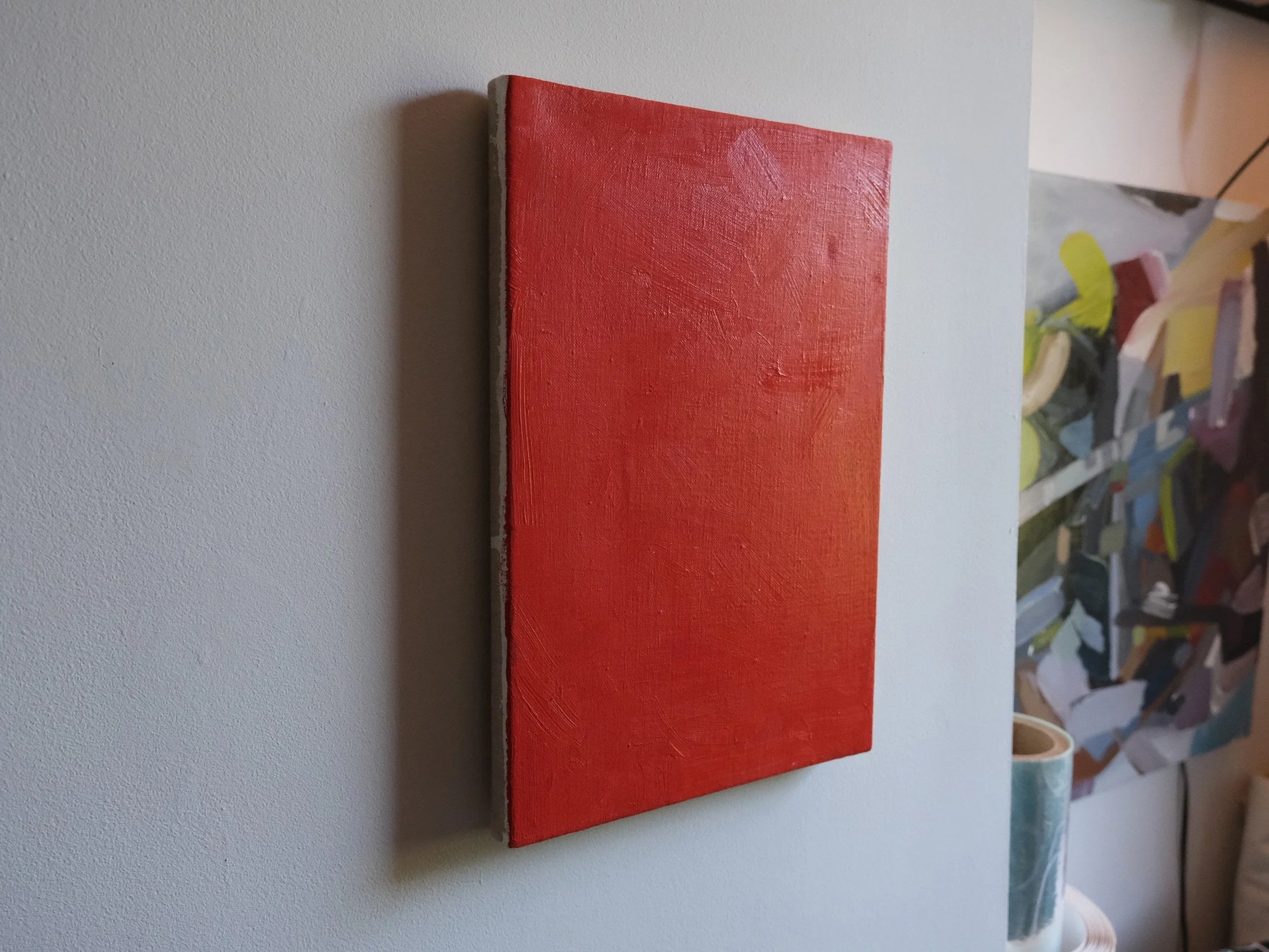My Pointless Red Painting
I had half a tube or more of cadmium red, a toxic pigment.
In recent years, when I have to replace the less-safe pigments I buy a pigment substitute that is non-toxic, or less toxic. In this case cadmium red “hue“ or some other orange-red.
The thing about paints that use heavier elements for pigment, other than their toxicity, is that they’re very powerful when you mix them and also have great coverage. It takes less paint to mix the same color and less to paint with. That means that over the years, despite trying to get rid of it, I always have toxic paints sitting around.
For maybe 6 years I took a pinch or a squeeze out of that one red paint tube, but the undying tube held on. It was messy and brown-looking, covered in every paint I had. At that point, my impulse was to just ditch it.
So I made a monochrome red painting with what was left.
A cadmium painting.
Underneath the painting is Belgian-style linen. You can see mottled strokes in the texture of the surface and dried gesso spilling around the sides.
There are a few noticeable unintended white specks on the red, I assume from something I was working on nearby after it dried, probably right next to it.
Out of all the paintings I’ve made this one has hung the longest in my living spaces. It’s been hanging in my bedroom near the ceiling on a wall that doesn’t get much sunlight.
I hang it in the darker corners or meager places where bright red is less noticeable but where it might draw attention away from uglier things.
To place a square of straight-up bright red in a room feels designer-y to me. Perhaps a high-price modernist, utopian vision, or an otherwise depressingly small gesture; like the artist was hit with a moment of stark boredom.
In TV shows the filler episodes are the ones you can skip without missing any information about the story, characters, or plot. I think this is a filler painting. Skippable, and forgettable too I think.
When people notice the painting in my apartment they ask me,
“Why did you paint that red one?”
“I had to use up the paint.”
There was nothing more to say. I think it’s surprising how pointless it is.
Failure and opportunity
If I stretch my imagination looking for a bigger purpose for this painting, that might go against its origin or its intent. What if it’s “anti-purpose” art or something?
You might be thinking that my pointless choice and expedient paint usage is actually, a solid, meaningful way to make art. “A theory of anti-purpose” sounds pretty unnecessary. Perhaps you’re wondering if that’s the point of this story.
Though I may have reinforced that take by talking about it here, that’s not where I’m headed exactly. Besides, that wouldn’t be as much fun, don’t you think?
We can go much further with pointlessness before giving up on it.
I feel like doing something actually “for no reason” is incredibly rare.
Art is certainly not something you would think is done without purpose no matter how obscure. The purpose could be anything. Who is to say? Surely the artist has intent.
I fail to explain the intent behind my paintings all the time, but there is, at minimum, a thoughtful process behind it, and I feel there is a driving point to each painting. The right words will eventually come -from me or someone else- to describe that point, but is that true for the red painting?
To make a red rectangular block on linen with no drawing, no details… What does that mean?
Perhaps it’s a mimic of nature (haha).
Nature doesn’t have any intentions. So many random things can take on crafted forms without any intent. A river in the past creates a walking path in the present; animals and plants, doing whatever hard work they do, produce emergent, surprising results.
If natural processes lead to things we see purpose and meaning in, maybe this pointless painting is a big bundle of secret potential. Maybe all it needs is a story.
Perhaps it’s dug up after the apocalypse and studied, or stuck in some important person’s bookshelf for a number of years, I don’t know.
The red painting may be an object of interest because it’s simple and reflective. Like a pool of water, you bring yourself and see whatever you see.
People are too good at making up the reasons for what they do and too good at seeing meaning in objects. All that’s needed is a simple question or a momentary reason to think.
It’s so easy to write about a painting with no purpose.
A thought experiment
Tying your shoes.
Philosophically (I’m still talking about art here), until you have completed the task you can’t 100% pre-determine the cause and effect that it will have. You definitely can’t say how meaningful that outcome is before it’s done.
For tying your shoes, the intent is simple and practical and the result can be easily pictured in your head.
Let’s say instead that I break physics first (sorry about that).
Let’s try tying our shoes now.
Every time you attempt to tie your shoes the laces slink off each other like little eels, they slide impossibly with frictionless movements not driven by the laws of physics that we know, and they continuously untie themselves.
What steps would you take to go back to the certainty of what used to be tying your shoes? Is there any knot that will work now? Do you need to invent an entirely new concept to deal with this?
That’s peak creativity and potentially important if we ever had a reason to question shoe-tying. (You tell me about that).
What becomes of purpose, usefulness, and intentional action when you can’t even predict normal things like natural physical forces?
In that reality, if tying your shoes has a purpose, we might not know what it is. This is also how a lot of art operates, and there is beauty in not knowing.
Pointless
Okay, I’ll come clean. I feel that people put too much weight on intent in the arts. When I’m asked about intent I feel the urge to explain art more broadly, because that question is not a very helpful one.
I am sure that if you think anything is simply made with a clear purpose or without one you have succumbed to a fallacy. Both options are equally useless.
As an example, look at this Instagram account that posts pictures of abandoned paintings. I think it’s obvious that leaving a painting on the street for the trash man doesn’t change the opportunity they each present to question and find meaning.
It’s almost better that we can ignore whoever the artist is or whether it had any point to it ever before. There’s no artist to muck it up. No institution to overburden it. Whatever the point was it’s trash now!
In my case I substituted artistic intent for the banal problem of using up a paint tube I was sick of looking at. I didn’t throw away the painting but I was taking out the trash.
So what’s pointless?
I don’t think there was much conflict in making the red painting.
It’s nice when an artwork looks like the thing it’s intended to be but honestly, it just doesn’t matter. Any response to the work, including the way the artist imagines it to be is just a description and a hypothesis at best.
Even shoelaces, why they exist, and if they do anything meaningful, can be questioned in a thousand ways. Perhaps the point of shoelaces is not in the design but in the answer to those questions. The study of new meanings and interpretations of reality, aesthetically or otherwise, has got to be the widest field imaginable.
A final thought about the cadmium painting:
When I look at the painting now, (and given what we explored above), it reminds me how objects are not useful, not meaningful, and not purposeful. It’s people that create meaning and seek out utility. People always find purpose, but people can also be wrong.
Thank you for reading.
David
David Tompkins is an Artist, Writer, and Content Strategist
Short Comment and David Eli Tompkins Studio New York, NY 10009
All images by David Tompkins




